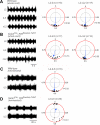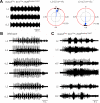V1 and v2b interneurons secure the alternating flexor-extensor motor activity mice require for limbed locomotion
- PMID: 24698273
- PMCID: PMC4096991
- DOI: 10.1016/j.neuron.2014.02.013
V1 and v2b interneurons secure the alternating flexor-extensor motor activity mice require for limbed locomotion
Abstract
Reciprocal activation of flexor and extensor muscles constitutes the fundamental mechanism that tetrapod vertebrates use for locomotion and limb-driven reflex behaviors. This aspect of motor coordination is controlled by inhibitory neurons in the spinal cord; however, the identity of the spinal interneurons that serve this function is not known. Here, we show that the production of an alternating flexor-extensor motor rhythm depends on the composite activities of two classes of ventrally located inhibitory neurons, V1 and V2b interneurons (INs). Abrogating V1 and V2b IN-derived neurotransmission in the isolated spinal cord results in a synchronous pattern of L2 flexor-related and L5 extensor-related locomotor activity. Mice lacking V1 and V2b inhibition are unable to articulate their limb joints and display marked deficits in limb-driven reflex movements. Taken together, these findings identify V1- and V2b-derived neurons as the core interneuronal components of the limb central pattern generator (CPG) that coordinate flexor-extensor motor activity.
Copyright © 2014 Elsevier Inc. All rights reserved.
Figures









References
-
- Al-Mosawie A, Wilson JM, Brownstone RM. Heterogeneity of V2-derived interneurons in the adult mouse spinal cord. Eur. J. Neurosci. 2007;26:3003–3015. - PubMed
-
- Batista MF, Jacobstein J, Lewis KE. Zebrafish V2 cells develop into excitatory CiD and Notch signaling dependent inhibitory VeLD interneurons. Dev. Biol. 2008;322:263–275. - PubMed
Publication types
MeSH terms
Substances
Grants and funding
LinkOut - more resources
Full Text Sources
Other Literature Sources
Molecular Biology Databases

